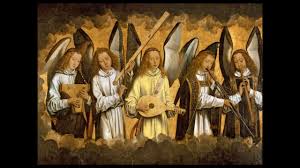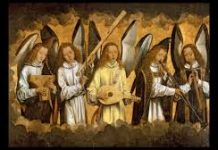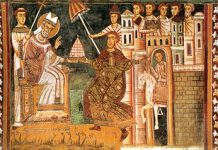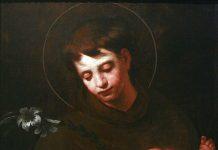Among the composers of Renaissance England, Thomas Tallis and William Byrd are easily the best known, but they are not the only composers to emerge from Our Lady’s Dowry. Among the older generation, Robert Fayrfax (1464-1521) and John Taverner (c.1495-1545) are more familiar, but one master of this style remains neglected.
Nicholas Ludford was born about 1485. Unlike Fayrfax, he held no degrees, and even in his lifetime seems to have only been known locally. Ludford was employed as a verger at the collegiate chapel of St. Stephen’s, Westminster, where his responsibilities included playing the organ and singing. His Missa Lapidaverunt Stephanum, based on the Antiphon at Lauds for the feast of St. Stephen, speaks to his involvement there.
Many of Ludford’s compositions are contained in the Lambeth, Caius and Peterhouse Choirbooks. Despite his obscurity, he holds the place as the most prolific composer of Masses in Pre-Reformation England, with a total of seventeen know Masses, although three are lost and three exist only in fragments. Ludford composed a complete cycle of Lady Masses in three parts with both the Ordinary and Propers, intended for use in the smaller chapels of larger institutions. The part books bear the coat of arms of both Henry VIII and Catherine of Aragon and belonged to their collection of manuscripts. This cycle of Masses was perhaps a gift from Ludford to the king and queen.
Contemporary accounts of Ludford depict him as reserved and very devout. Unlike Thomas Tallis (c. 1505–1585) and John Sheppard (c. 1513–1558), Ludford did not adapt to the demand for a change in styles after the English Reformation, and instead stopped composing in 1535. Nick Sandon notes, “Ludford’s music is of the highest quality, comparable with that of any of his contemporaries, but unlike that of Taverner it did not continue to be copied into later-sixteenth- and early-seventeenth-century musical collections. One reason for this could be that since none of his surviving music has quite the directness and economy of scale that some of Taverner’s has, it did not appeal to Elizabethan and Jacobean taste; another reason might be that because no story about repenting his Catholic past and accepting Protestantism became attached to him as it did to Taverner, he was not regarded as ‘one of us’ but became a symbol of a vanished order.”[1]
Under Sir Richard Terry, Ludford’s music resurfaced, being sung in Westminster Cathedral in 1913. In 1993 The Cardinall’s Musick released the first recording of Ludford, with a total of four volumes. Among the excellent recordings available, New College Choir, Oxford has recorded the Missa Benedicta and the votive antiphons Ave Cuius Conceptio and Domine Jesu Christe in what is the only recording to date with boy trebles, which is how this music would have been originally sung.
Stylistically, Ludford frequently employs a cantus firmus technique, in which the initial motivic idea is based on a chant melody. It is also surprisingly florid compared to the music of the much-younger recusant composer William Byrd (c. 1540–1623), which seems more akin to Palestrina on the continent. Nearly all of the individual movements in Ludford’s output are at least ten minutes in length. One must wonder if time worked differently in the Sarum Mass during the 16th century, for such a long Mass setting would be unacceptable at most Masses in the usus antiquior today. It is possible that Ludford’s glorious Masses will be confined to concert use in our perpetually-preoccupied age and never return to the liturgy. Perhaps this age could learn something from this florid music on how we can slow down and give God one of our most precious commodities — our time.
[1] https://www.blueheron.org/wp-content/uploads/2018/08/Sandon-notes-5CD-set.pdf











